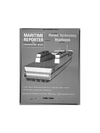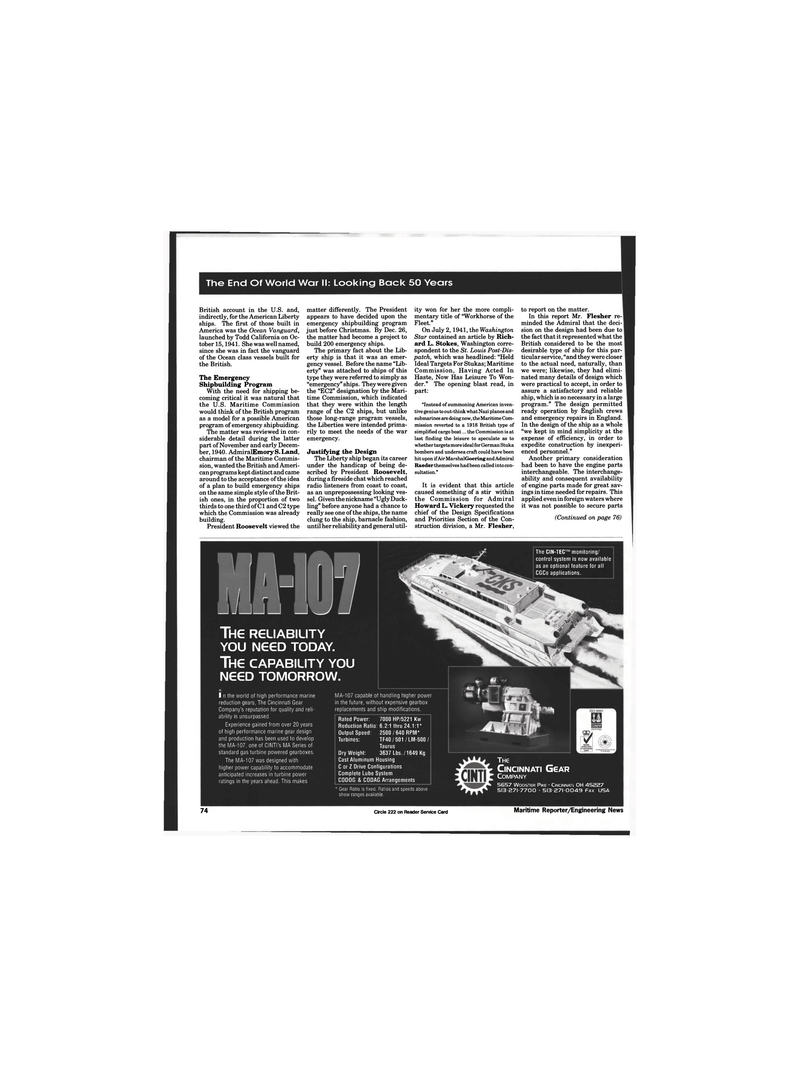
Page 62: of Maritime Reporter Magazine (April 1995)
Read this page in Pdf, Flash or Html5 edition of April 1995 Maritime Reporter Magazine
The End Of World War II: Looking Back 50 Years
British account in the U.S. and, indirectly, for the American Liberty ships. The first of those built in
America was the Ocean Vanguard, launched by Todd California on Oc- tober 15,1941. She was well named, since she was in fact the vanguard of the Ocean class vessels built for the British.
The Emergency
Shipbuilding Program
With the need for shipping be- coming critical it was natural that the U.S. Maritime Commission would think of the British program as a model for a possible American program of emergency shipbuiding.
The matter was reviewed in con- siderable detail during the latter part of November and early Decem- ber, 1940. AdmiralEmory S. Land, chairman of the Maritime Commis- sion, wanted the British and Ameri- can programs kept distinct and came around to the acceptance of the idea of a plan to build emergency ships on the same simple style of the Brit- ish ones, in the proportion of two thirds to one third of C1 and C2 type which the Commission was already building.
President Roosevelt viewed the matter differently. The President appears to have decided upon the emergency shipbuilding program just before Christmas. By Dec. 26, the matter had become a project to build 200 emergency ships.
The primary fact about the Lib- erty ship is that it was an emer- gency vessel. Before the name "Lib- erty" was attached to ships of this type they were referred to simply as "emergency" ships. They were given the "EC2" designation by the Mari- time Commission, which indicated that they were within the length range of the C2 ships, but unlike those long-range program vessels, the Liberties were intended prima- rily to meet the needs of the war emergency.
Justifying the Design
The Liberty ship began its career under the handicap of being de- scribed by President Roosevelt, during a fireside chat which reached radio listeners from coast to coast, as an unprepossessing looking ves- sel. Given the nickname "Ugly Duck- ling" before anyone had a chance to really see one of the ships, the name clung to the ship, barnacle fashion, until her reliability and general util- ity won for her the more compli- mentary title of "Workhorse of the
Fleet."
On July 2, 1941, the Washington
Star contained an article by Rich- ard L. Stokes, Washington corre- spondent to the St. Louis Post-Dis- patch, which was headlined: "Held
Ideal Targets For Stukas; Maritime
Commission, Having Acted In
Haste, Now Has Leisure To Won- der." The opening blast read, in part: "Instead of summoning American inven- tive genius to out-think what Nazi planes and submarines are doing now, the Maritime Com- mission reverted to a 1918 British type of simplified cargo boat... the Commission is at last finding the leisure to speculate as to whether targets more ideal for German Stuka bombers and undersea craft could have been hit upon if Air MarshalGoering and Admiral
Raeder themselves had been called into con- sultation."
It is evident that this article caused something of a stir within the Commission for Admiral
Howard L. Vickery requested the chief of the Design Specifications and Priorities Section of the Con- struction division, a Mr. Flesher, to report on the matter.
In this report Mr. Flesher re- minded the Admiral that the deci- sion on the design had been due to the fact that it represented what the
British considered to be the most desirable type of ship for this par- ticular service, "and they were closer to the actual need, naturally, than we were; likewise, they had elimi- nated many details of design which were practical to accept, in order to assure a satisfactory and reliable ship, which is so necessary in a large program." The design permitted ready operation by English crews and emergency repairs in England.
In the design of the ship as a whole "we kept in mind simplicity at the expense of efficiency, in order to expedite construction by inexperi- enced personnel."
Another primary consideration had been to have the engine parts interchangeable. The interchange- ability and consequent availability of engine parts made for great sav- ings in time needed for repairs. This applied even in foreign waters where it was not possible to secure parts (Continued on page 76)
The CIN-TEC™ monitoring/ control system is now available as an optional feature for all
CGCo applications.
THE RELIABILITY
YOU NEED TODAY.
THE CAPABILITY YOU
NEED TOMORROW.
MA-107 capable of handling higher power in the future, without expensive gearbox replacements and ship modifications.
I n the world of high performance marine reduction gears, The Cincinnati Gear
Company's reputation for quality and reli- ability is unsurpassed.
Experience gained from over 20 years of high performance marine gear design and production has been used to develop the MA-107, one of CINTI's MA Series of standard gas turbine powered gearboxes.
The MA-107 was designed with higher power capability to accommodate anticipated increases in turbine power ratings in the years ahead. This makes
Rated Power: 7000 HP/5221 Kw
Reduction Ratio: 6.2:1 thru 24.1:1*
Output Speed: 2500 / 640 RPM*
Turbines: TF40 / 501 / LM-500 /
Taurus
Dry Weight: 3637 Lbs./1649 Kg
Cast Aluminum Housing
C or Z Drive Configurations
Complete Lube System
C0D0G & C0DAG Arrangements
THE
CINCINNATI GEAR
COMPANY 5657 WOOSTER PIKE • CINCINNATI, OH 45227 5I3-27I-7700 • 5I3-27I-0049 FAX USA Gear Ratio is fixed. Ratios and speeds above show ranges available. 74 Circle 222 on Reader Service Card Maritime Reporter/Engineering News

 61
61

 63
63
